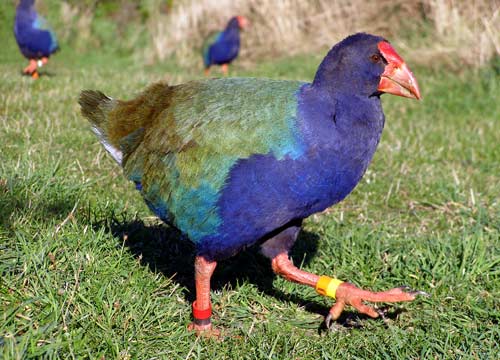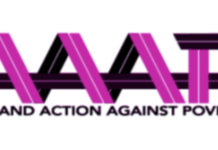The killing of four takahe on Motutapu Island sanctuary is a tragedy on many counts. With fewer than 300 takahe left on the planet, that’s between 5 and 7% of the total population gone. The Guardian reports in terms of impact on an endangered population, it’s equal to killing 160 tigers or 93 giant panda. It’s a disaster for those four takahe and an insult to conservation, adding to the injury we’ve already inflicted on this curious and quirky species.
The accidental killing of the four takahe highlights significant other problems too. Something so astounding, so unbelieveable, so abhorrent, has to be evidence of systemic problems arising from the current Government’s conservation funding model impacting on the capacity of the Department of Conservation to do its job.
Everything about this picture is wrong. The Department of Conservation, following a ‘partnership’ model which devolves important operational functions to the private sector and volunteers, ‘contracts’ the Deer Stalkers Association to kill 600 pukeko on an island sanctuary. If we judge the case on the outcome, this shows a problem with the model, the funding, the level of discretion delegated away from DoC, and the conservation management approach on the island itself.
DoC apparently identified a problem with pukeko numbers on Motutapu, with fears that even though they’re not a ‘regular predator’ they might eat takahe eggs and young. Even though pukeko are also a native bird, (but clearly not an endangered one), DoC contracted the Deer Stalkers Association to kill them 2012, 2013 and again in 2015. 600 is a big pile of dead pukeko, and the place must look more like a bird blood bath than an island sanctuary for native animals by the end of it. Any animal lover should cringe at the mass shooting of pukeko as a conservation management strategy, for its wanton destruction of friendly, intelligent and sentient life. It’s clearly an ineffective approach if even on the third attempt 600 pukeko (and four takahe) are in the firing line.
An ethical approach to managing pukeko on Motutapu would require an evidence based approach, and a sound plan where risks are anticipated and avoided. More sustainable, efficient and humane techniques for managing the pukeko population should have been implemented prior to the introduction of the takahe. Overseas evidence confirms that ‘culling’ is an ineffective population management strategy anyway as in the long term, species will repopulate an area. Non-lethal control methods and egg management are clearly more ethical, and safe, than the wholesale slaughter of one of New Zealand’s most commonly recognised birds. That’s not to mention the subjectivity and speciesism inherent in DoC officials deciding that the risk to takahe chicks and eggs outweighs the lives of 600 pukeko this year alone.
But while the ‘why’ motive for killing 600 pukeko is questionable, the ‘how’ this event happened, is off the planet. The cascade of failings shows systemic problems with the Department of Conservation’s ‘partnership’ approach.
How did the Deer Stalkers kill four takahe when they were each satellite tagged and their location known? Clearly inadequate separation distances and precautionary methods were applied. How did the hunters fail to distinguish takahe from pukeko given the seriousness of the need for distinction?? DoC say the hunters were given a full briefing, and were instructed to only shoot birds on the wing. The briefing was not ‘full’ enough or was not understood, and as takahe don’t fly, the hunters must have failed to follow the rules and blasted their shotguns indiscriminately. How come the hunters failed to identify their targets (at least four times!) when using firearms in a public space? Supervision of these unskilled volunteers was clearly not what it needed to be, given the outcome.
Predation from pukeko proved less a threat to takahe than the impacts of volunteer hunters. A rare and special bird that has been brought back from the dead once already, was pushed back there a little bit more by a strategy that delegates sensitive tasks to those ill equipped for the job. Although a DoC worker also shot a takahe, on Mana Island seven years ago, there’s limited capacity for institutional learning from this in DoC operations, when most of the institution is gutted and volunteers now do most of the previous workers’ jobs.
The Deer Hunters Association have apologised to DoC and to New Zealand at large. Condemnation and dismay won’t bring the takahe back, but there’s time for the pukeko killing spree to stop. Mass killing of native birds is not an ethical conservation strategy, and indiscriminate killing is a hazard to conservation and to the public. DoC’s credibility has been severely damaged from this sad event. But the killing of the birds DoC is supposed to save, also shows significant problems with the broader ‘partnership’ model. In terms of lessons for the Government’s resourcing and management of the Conservation portfolio, this should be a wakeup call that’s the endangered species equivalent of Cave Creek. Professionalism and oversight are essential in conservation to avoid risks to people, and the environment.
Disclaimer
Christine Rose is employed as Kauri DieBack Community Co-ordinator by the Auckland Council. All opinions expressed herein are Christine’s own. No opinion or views expressed in this blog or any other media, shall be construed as the opinion of the Council or any other organisation.






Just another example of the incompetence of neo-liberalism system we live under. The stupidity and short sightedness is right across the spectrum.
and of course we will never know those culpable either. The gungo-ho prats who did this would not have the balls to stand up and admit and apologise – not just to NZ – but the world.
What a disgrace. The blame should not necessarily fall on ‘DOC’ as a whole as the fieldworkers are excellent. The regime and policies are responsible.
I can assure you that pukeko definitely prey on other birds’ young. I grew up next to Hamilton Lake… A pukeko ran past bread thrown to it to seize a very young duckling and run off with it. No trouble at all. (Fortunately, there is no shortage of ducks.
One wonders just how many deer-hunters are experts with shot-guns..
I can assure you that pukeko definitely prey on other birds’ young. I grew up next to Hamilton Lake. A pukeko even ran past bread thrown in its path to seize and run off with a very young duckling. (Fortunately, there is no shortage of ducks..)
One wonders how many deer hunters are expert with shotguns…
Unbelievable!!! Their should never ever be an excuse to cull a native bird for another native bird and of course the stupid arsehole idiots shot the ‘protected’ bird that looks exactly like the ‘over populated native bird’. Brilliant!
This takes the cake for absolute idiocracy, someones head better roll for this. DOC is just as wrong as Sonny Tau for being in possession of dead kereru who had to endure trail by useless media. Who is the muppet who decided culling everything on an island with features was a good idea????
Has DOC become the Department of Culling.
Anyone with half a brain could foresee this happening, trigger happy, poison dropping, halfwits. What a bloody hypercritical embarrassment this country has become. That someone was paid to make this decision, makes my mind boggle. So these unfeeling, unthinking bureaucrats believe that a gun hunt and poison drops are conservation. I feel so sorry for all the good people doing the voluntary work to be fucked over by the paid incompetent at the Department of Culling.
Here is an example of better conservation methods been led overseas due mainly to a public outcry.
“Almost 30 years after the hedgehogs were first introduced to the Hebrides, an organisation called the Uist Wader Project was formed to launch a cull of the hedgehogs, in order to prevent the nesting waders being wiped out. (Sound familiar)
The project – a coalition between Scottish Natural Heritage, RSPB Scotland and the Scottish Government – did manage to cull about 700 hedgehogs, but this soon attracted criticism: partly because there were still so many hedgehogs remaining at large, and partly because this had reportedly cost more than £800 per hedgehog in taxpayers’ money. (Sound familiar)
The biggest barrier to the continuation of the cull however was not financial, but emotional. Many people – both on the islands and elsewhere – were angry that the hedgehog, an otherwise harmless mammal, was being targeted and killed at the same time as it was disappearing from much of mainland Britain.”
“During the next three years they relocated more than 700 hedgehogs, and once they had shown that relocation was both feasible and effective then in February 2007 the cull was halted.”
“Instead of killing the animals, Scottish Natural Heritage began to fund the translocation project run by UHR instead. So far about 1600 hedgehogs have been safely removed from the islands and relocated elsewhere.” (Why didn’t they even consider that here?)
http://www.bbc.co.uk/nature/22093131
This is not the first time that DOC have been questioned over their methods, especially over the use of 1080 poison. Why are they using a poison able to kill larger mammals (they limited its use in the US because it was found to have killed wolves) on rats. Why are we siphoning off millions of taxpayers dollars to prop up a US chemical company. We are almost an exclusive client, using about 80% of the world’s supply. Why haven’t we found alternatives yet to a poison developed during WW2!
http://jacksonville.com/tu-online/apnews/stories/121304/D86UI3MG1.shtml
The ipad changed the word feathers to features! Doh!
So the sentence to my previous post should be culling anything with feathers. That is if my post uploads this time.
Clean, green and full of shit. This is what New Zealand stands for. Six hundred pukeko being culled. That is slaughter by anyones definition. Where is the outcry there?
How does New Zealand market itself, at home and to the world…
Remember these ads…
http://youtu.be/ghGPbuqj2As
Good piece buuuuuuuut…
… it repeats the Guardian’s mathematical illiteracy. Four killed from a population of 300 odd – approx. 1.3% – is well short of 5-7%.
While I agree with Christine’s argument (and have no faith in deer hunters who mistake themselves, their mates and schoolteachers brushing their teeth for deer), we should stick to the facts. They’re sufficiently outrageous on their own.
The 5-7% figure comes from two different sources, and refers to the wild population. Apparently the more accurate figure of total takahe is 235, but not all of them are in wild populations. Maybe I needed to be clearer about how that per centage was derived. 🙂
Not particularly good advertising for the competence of DOC or the Deerstalkers Association.
Sounds like the Annual Mr Beans Motutapu Pukekohe Hunt.
So the gunners had been specially trained so they could tell the difference between takahe and pukeko, were they? Yeah right! Apparently they were supposed to only shoot at flying birds, with the reasoning that it was flying it had to be a pukeko, because takahe can’t fly. Seemed that they didn’t follow instructions. But when you think of it, if a lot of hunters can’t even tell the difference between a deer and a human, who look nothing alike, before they shoot, how can you expect them to be able to tell takahe and pukeko apart when they actually look similar from a distance. Incompetent clods and those who hired them are equally incompetent. Heads should roll!
The Deer Hunters Association should simply be charged with the crime of killing protected native species under the Wildlife Act, i.e. $100,000 + 1 year in jail for the perpetrators (if no one owns up, I’d be fine with simply throwing all the “hunters” in jail in this case). That will be the first and last time they do it, I suspect.
http://www.doc.govt.nz/parks-and-recreation/things-to-do/hunting/what-to-hunt/protected-species/
The stupid around here burns. Christine has no comprehension of a pest management plan, but niether does doc. doc live by the poison it and walk away for many years, a real management plan looks nothing like that.
doc have been killing native endangered critters for a long time now. So why is this instance so different? Why are you all up in arms about this one???????
Why did doc 1080 an area with a white Weka in it? A fucking sight rarer than a fat swamphen. And they had been told and shown photos of said Weka.
These part time naturalists make me sick as they have no fucking idea what is actually going on in OUR country.
Stephen you’re quite rude, and quite wrong. You know nothing about my experience with pest management and there’s no logic to your statements. Not sure why I am the target of your diatribe when DoC here is the more rightful target.
Quite wrong? You made the statement “overseas evidence confirms that ‘culling’ is an ineffective population management strategy anyway as in the long term, species will repopulate an area. – ”
It works just fine IF used properly, and remember this, the egg thing you are on about. Well that is a form of culling.
Because you don’t understand proper pest management plans including culling in fact proves how little you know about the situation so what gives you the right to make blanket statements that in fact are wrong.
Why do I get pissy about all this shit? I am sick and tired of people talking shit about stuff they obviously know not much or nothing about.
Do I know a bit about it? I should because it’s my job.
By the way, statements like overseas they say culling doesn’t work and NOT having reference material is a lot like john key saying everything is good.
Stephen, pull your head in, mate. Your self-righteous anger is not only mis-directed, but you do your cause (whatever it is) no good whatsoever.
Perhaps you should be venting your spleen at this current government that has cut DoC’s budget to such a degree that they have to rely on volunteers to carry out their projects.
That is where you should be venting. Not at those raising the very issues and problems that seems to have attracted your ire.
Oh, and before everyone starts blaming the latest round of stripping doc out for all this shit, this has been going on for many years involving doc.
DoC was underfunded (by Labour) from Day One. And understaffed.
Those practical yet not-nice field people who knew what to shoot, when to cull and how, were replaced over time by Properly Qualified People who generally aren’t quite so deft with a .22 but are well-soaked in neo-liberal dogma, thanks to a few hopeless Directors-General.
In all the indignation – did anyone get the feathers? And what happened to the carcasses?
Our native species live in a highly altered environment. They face pressures due to human activities, introduced predators and climate disruption to name just to name a few. Some species such as pukeko are more resilient than others as they have benefited from land clearance.
Many species have already been lost and without human intervention the extinctions would continue. The question then becomes one of judgement as to the level of human intervention. This is the dilemma all conservationists face.
This current display of incompetence does not alter the fundamental case for management of species in this altered environment. Managing the numbers of pukeko is necessary as they multiply rapidly in wetlands and open grassland sanctuaries free from predators. How they are managed obviously needs work.
Comments are closed.